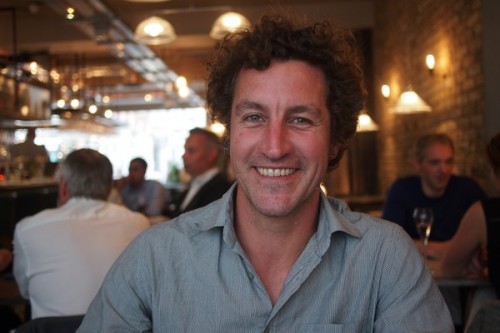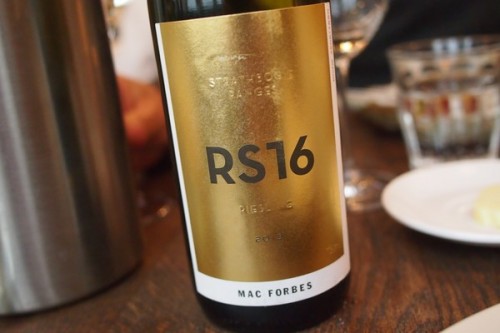
Mac Forbes was in town so we lunched at 28:50 in Maddox Street. I’ve long been a fan of his wines, and wrote about him at length here. But I can’t believe it has been almost four years since we last caught up properly!
He’s currently in a happy place, after going through a more difficult period.
’12 months ago I was discouraged,’ he shares. The main problem was the arrival of phylloxera in the Yarra Valley, which was looking to threaten some of the older vineyards he’s working with. ‘It’s our biggest challenge,’ he says. All the vineyards he leases are planted on their own roots; the youngest is 20 years old and the oldest is 38. And although Mac doesn’t own any vineyards, he spends a lot of money on the ones he leases, and now has three skilled vineyard people working for him. ‘It’s a lot cheaper just to buy fruit.’
He takes a lot of care not to let phylloxera get into his vineyards, but some of the other wineries aren’t so careful. ‘There are trucks turning up covered in dirt coming from regions in phylloxera zones from big wineries,’ says Mac. He quarantines every vineyard in terms of equipment, and uses disposable body suits for pickers (who will have been in other vineyards). So the challenge now is to see how it is possible to get resistant rootstock into vineyards without sacrificing vine age. And Mac has a clever plan.
The idea is to plant American rootstock vines as close as possible to existing trunks. Then, if phylloxera comes, he can graft this rootstock into the existing vine. Yes, the root system of the rootstock vine won’t be fully developed. But vines don’t die immediately from phylloxera, so there might be a five year handover period. It could just work.

Mac says he is learning a lot from seeing how his vines have adapted to the vineyard sites. An ex-employee of his is now doing a PhD on epigenetics and vine age. Are vines adjusting to the particular patch of dirt that they find themselves in? It’s an interesting question.
‘I’ve just had the finest vintage I have ever had,’ says Mac. ‘A few years ago I was pulling my hear out. It’s a bloody interesting time to be in the Yarra.’ He’s now completed 10 years of his solo project. He’s shifted his emphasis from valley floor vineyards by letting a couple go and taking on some new ones. He’s also more relaxed about letting each site and vintage express itself. ‘When we started, winemaking was outcome driven,’ he says. ‘We wanted to make wines that were elegant. Now, because of the strength of our key sites, I don’t worry where the wines will end up. The outcome will take care of itself if we do everything right along the way.’
Mac has some interesting things to say about picking. There’s no easy way to determine whether grapes are ‘ripe’ or not. On one site, he was ready to pick Pinot Noir because the tannins and acidity seemed just right, but there were no flavours in the grapes. But he picked anyway, and it turned out to be the Pinot with the most flavour and intensity in the winery. All the flavours were bound when they were in the grape, only to be revealed during the winemaking process. The key factors for him are the vitality and the tannins. He cites a two day difference in picking date in Woori; the earlier picked wine was vital, the wine made from grapes picked just two days later was dull.
In warmer sites with his Pinot Noir he has been using more stems. After experimenting (trials are ongoing) he says he favours hand destemming (to protect the stems) and then adding the stems back, which seems to give the best results.
We tasted some wines, although it was clear that Mac doesn’t think they are all his best. He found 2013 a very hot year, and cautioned me that this isn’t the most representative sample of what he’s up to now. But they still tasted pretty smart.

Mac Forbes Woori Yallock Chardonnay 2013 Yarra Valley, Australia
Textured and fine with lovely pear, peach and citrus fruit, with just a hint of minerally matchstick. Lovely purity here with nice texture and real finesse. It may be from a very warm year but it is balanced and harmonious. 94/100
Mac Forbes RS16 Riesling 2013 Strathbogie Ranges, Australia
The pressings weren’t used this year. Mostly fermented in large oak (Stockinger). Very floral, rich and pure with textured fruit and a bit of sweetness. Lovely generosity and purity here, with silky lemony fruit. 92/100
Mac Forbes RS33 Riesling 2014 Strathbogie Ranges, Australia
Very pretty with melon, grapefruit and a bit of spice. Lively, intense and floral with a hint of ginger spice (skin derived). So lovely. 93/100
Mac Forbes Pinot Noir 2013 Yarra Valley, Australia
Fresh and a bit peppery with a hint of ginger, and sweet focused berry fruits. Nice juicy, sappy style that’s very drinkable. 91/100
Mac Forbes Coldtsream Pinot Noir 2012 Yarra Valley, Australia
This is the only lower Yarra vineyard Mac works with now. Supple, sweet red cherry fruit with nice detail and precision, as well as some raspberry freshness. Detailed and fine, showing depth and freshness, even though it is from a warmer site. 94/100
Mac Forbes Hugh 2011 Yarra Valley, Australia
Named after his father, this is a Bordeaux blend made from a vineyard in Gruyere that Mac started working with in 2007. ‘This is the blend that built the Yarra,’ says Mac, ‘and no one shows respect to it. People say you can’t make medium-bodied Cabernet any more. This is a lovely wine: fresh, gravelly and a bit spicy with a lovely mix of red fruits and black fruits, with sweet blackcurrant and a nice greenness in the mix. So elegant. 94/100
Love his wines.
Agree with winerackd, only had his Chardonnays and Pinots but top quality,elegant wines – will seek out the rieslings based on your review Jamie
Very interesting. I liked your comment about the Hugh 2011- “nice greenness in the mix”. Obviously an elegant Cab. Some of my colleagues in South South Africa are apopleptic about so called “greenness” in Cab, going so far to call it a fault. How can it be a fault if it comes from the grape? It’s good to see other new world producers striving for elegance and freshness rather than the subjective “physiological ripeness”.